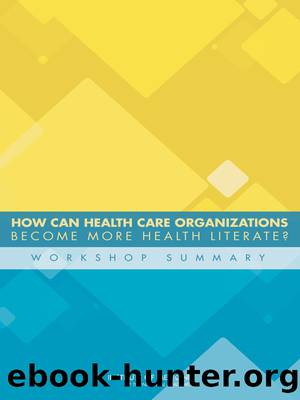How Can Health Care Organizations Become More Health Literate?: Workshop Summary by Roundtable on Health Literacy

Author:Roundtable on Health Literacy
Language: eng
Format: epub
Tags: ebook
Publisher: The National Academies Press
Published: 2012-12-28T00:00:00+00:00
THE CENTERS FOR MEDICARE AND MEDICAID SERVICES (CMS) PERSPECTIVE
Shari Ling, M.D.
Office of Clinical Standards and Quality
Health literacy is an important topic at a critical time when the country is facing limited resources, Ling said. All of the attributes discussed in the paper are important. They speak to different parts of the system and different issues. Rather than discuss individual attributes separately, Ling bundled them into a few categories and said she thought that it may be worth considering the bundles in terms of what can be done immediately using existing resources versus what requires more long-term solutions. One could also think about them in terms of what is actionable rather than what is ideal. Finally, perhaps those attributes that require health system redesign could be reframed in terms of what can be accomplished or achieved without a complete redesignâthat is, what can be tackled now.
The first of the attributes that is critically importantââPromoting health literacy as an organizational responsibilityââfalls into the bundle of culture change and the acknowledgment that culture matters. Culture matters for the patients and for the families; it is the filter through which all information flows. This attribute is fundamental but is also the greatest challenge. Other attributes in this bundle include the following:
⢠Encourage active inquiry, innovation, evaluation, and improvements.
⢠Encourage and expect question asking.
⢠Assess the communication climate.
⢠Recognize and overcome communication barriers.
⢠Target population health literacy advisory group.
Another important bundle of attributes relates to attention to content. This is particularly crucial in the area of medication safety and communication about medication safety. Conversations around this issue must balance the risks versus the benefits of the recommended interventions. That conversation is dependent upon the patient understanding and believing what is being said, and understanding requires health literacy.
Infrastructure is another important bundle of attributes. There are long-term and short-term infrastructure requirements. âProvider, patient, and family technical assistanceâ could be provided immediately by offering educational materials that can actually be read and understood. âEnhancing health care system navigability,â particularly across transitions, could be addressed in the short term. Longer-term infrastructure requirements include âLeveraging health information technology,â âProviding personal health records,â and, again, âEnhancing health care system navigability.â
In an earlier presentation, Darren Townzen had offered a surprising but informative piece of information when he said that even when personal health records are available, they are not necessarily used. What can be done to make them usable? That is a longer term effort that needs to be undertaken, Ling said.
The final bundle of attributes relates to developing needed skills and tools for the workforce, the individual, and the community. There is an opportunity for private and public partnerships to develop and apply techniques that are never taught in medical school, for example, techniques that are based on learning theories. What motivates an individual to learn? How can understanding this motivation be applied in the medical setting? What lessons can be learned by both providers and patients? The bundle includes the following attributes:
⢠Assess and track patient comprehension, skills, and problem solving.
Download
This site does not store any files on its server. We only index and link to content provided by other sites. Please contact the content providers to delete copyright contents if any and email us, we'll remove relevant links or contents immediately.
Human Diseases (MindTap Course List) (by Team-IRA) by Marianne Neighbors Ruth Tannehill-Jones(846)
The Neglected Dimension of Global Security: A Framework to Counter Infectious Disease Crises by National Academy of Medicine Secretariat(422)
Statistical Methods in Health Disparity Research by J. Sunil Rao(399)
Imaging in Urology by Mitchell Tublin MD Joel B Nelson MD(395)
Short Course in Medical Terminology by Nath Judi L.;(331)
Cancer Cell Culture by Unknown(320)
Wilkins' Clinical Practice of the Dental Hygienist by Boyd Linda D.;Mallonee Lisa F.; & Lisa F. Mallonee(301)
Clinical Research in Occupational Therapy, Sixth Edition by Martin Rice;(300)
Murray's Basic Medical Microbiology E-Book by Murray Patrick R.;(282)
Anatomical Kinesiology by Gross Michael;(281)
Psychedelics As Psychiatric Medications by Nutt David;Castle David;(272)
Neuroscience Fundamentals for Rehabilitation by Lundy-Ekman Laurie(271)
Health Behavior: Theory, Research, and Practice by Karen Glanz & Barbara K. Rimer & K. Viswanath(271)
Achieving Procreation : Childlessness and IVF in Turkey by Merve Demircioğlu Göknar(251)
Rang & Dale's Pharmacology 9th Edition plus Flashcards 2nd Edition by Unknown(250)
Public Health and Society: Current Issues by Burke Lillian D.;Weill Barbara;(246)
The Handbook of Medicinal Chemistry by Simon E Ward;Andrew Davis;(245)
Primary Care Occupational Therapy by Unknown(239)
From Good Schools to Great Schools by Susan P. Gray & William A. Streshly(232)
